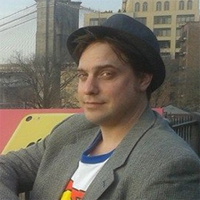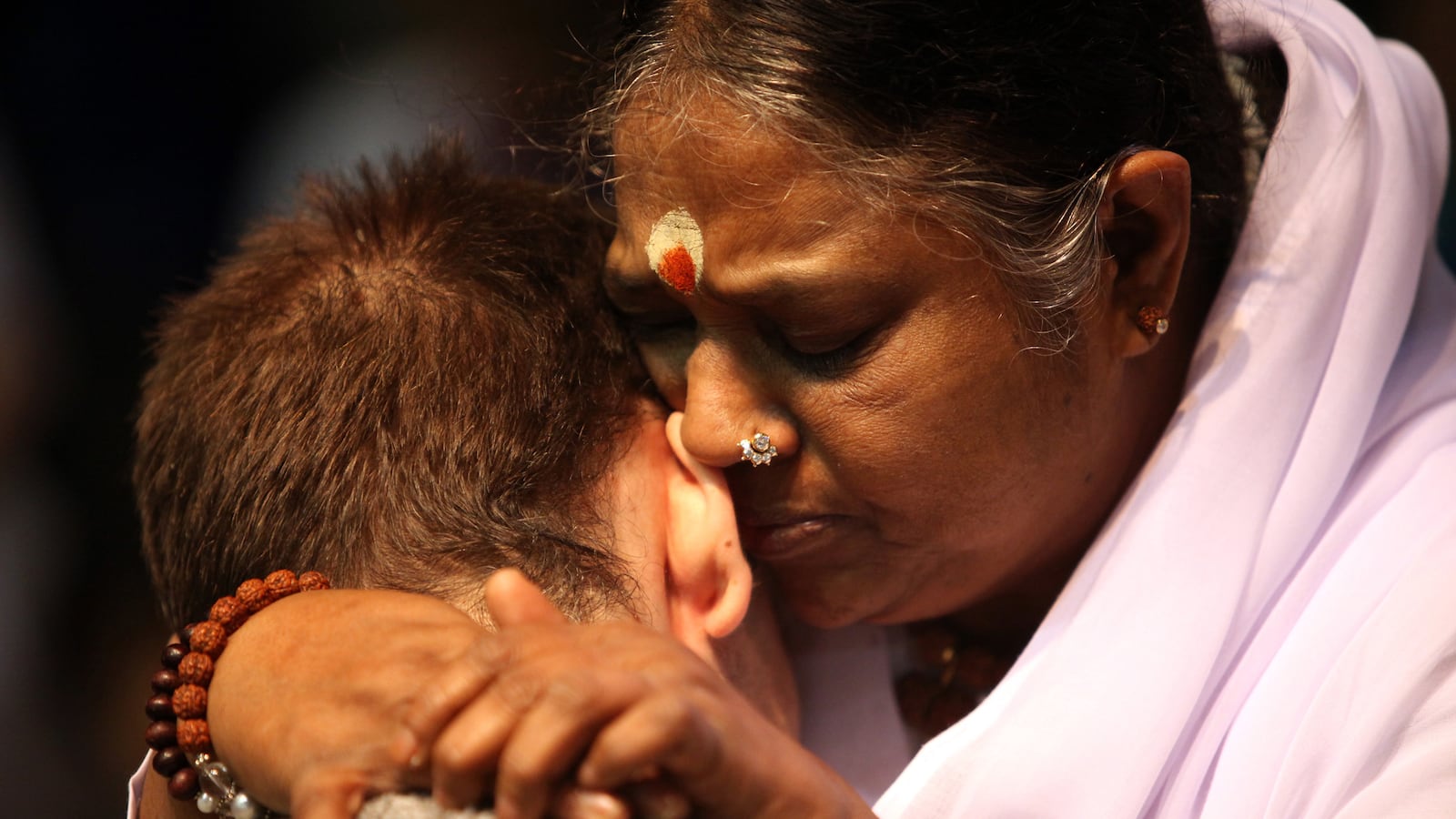Before last weekend’s event in New York, Amma, the Indian “hugging saint,” had embraced at least 34 million people around the world. It would be two more after my wife and I waited the twelve hours to receive the darshan, or gift. But Amma could not have known that in my case, she was laying hands on a man who had known touch in only the worst of ways for the last decade.
I served ten years in prison after being convicted of five amateur robberies. It took heroin addiction a year and nine months to take me from my desk at a literary agency to hold ups with a pocketknife. I did my minimum and was released early this year.
There were exceptions to the hurtful touches, like when my family visited the prisons I was in and I was kissed and my hands were massaged by my wife. But they weren’t enough for me to learn not to associate touch with oppression, hatred and pain.
Amma’s hugs, however, are rumored to alleviate cancer and cure mental illness. Her compound in India is very well funded and populated by an international cast of those looking for a guru, people who have never seen the film Kumaré, a 2011 documentary that shows the gullibility of Americans in the face of Eastern “wisdom.” Other allegations are more troubling. Recently, Gail Tredwell, a former devotee from Australia, who spent 20 years with Amma, wrote a book that alleged brutal beatings, scratchings and rape until she escaped. (Amma has denied the allegations and even expressed love for “that daughter.”) The Indian press has further speculated about financial improprieties and even murder. But while Tredwell’s book may have made a stir in the media world, for those in line for a hug at the Jacob Javits Center last weekend, some for the fifteenth year in a row, none of this is true; just the usual libel of a saint on earth. Jesus was crucified too, one woman told me.
As we waited (and waited; Javits was packed with Western "seekers" desperate for Eastern "truths"), I watched those hugged break into tears and fall into trances. One woman told me that while being embraced she saw a vision of a man bringing love into her life. Would Amma intuit—and being a poorly educated guru from a southern Indian village, intuition is said to be her strong point—that I had only known bad touch for years and could use a second helping of the good?
Inside the world of corrections, physical contact between humans, whether prisoner on prisoner or guard on prisoner, is tightly ritualized and regulated. Until the moments when it is not, and then the guards beat the shit out of someone who angers them, resulting in an extra charge for “resisting” to cover the bruises (which the medical staff are sometimes encouraged to ignore anyway). Prisoners are all starved for human contact, of which they are deprived of by the iron bars keeping them separate and the unwritten codes of machismo. But human needs break through, and convicts find ways to touch one another without bringing up dreaded homosexuality, much like companies of chimpanzees groom each other to show mutual admiration. There are elaborate handshakes and hugs that take much more time than one would expect. Necks are rubbed, pimples popped and haircuts given on a totally unnecessary, weekly basis. All of this is compensation for the lack of real touch between husband and wife, father and child, etc. And of course there is the truly bad touch that is humiliating, oppressive and often painful.
The frisks subsided after my security level dropped and I was transferred to a Medium institution, but during the seven years and four Maximum security prisons I lived through, they could be a daily occurrence and strike at the most unexpected of times.
Human beings can grow accustomed to just about anything, as Primo Levi described so poignantly when he accepted his own father’s death in Auschwitz, in The Drowned and the Saved, but it always remained jarring to me to have to squat and demonstrate that I have nothing hidden in my asshole. That was de rigeur after every visit, but it could happen in a hallway as well. And being patted down was frequent enough that I can assume the optimal position that leads to the least humiliation at the drop of a hat. Hands on the walls, eyes front, legs spread behind you. The nastier of the cops would make you pull your legs too far back from the wall, and those prisoners without massive upper body strength eventually lost balance. Taking a hand off the wall while being frisked was an “act of aggression,” and gave the cops instant grounds to take you down with a baton. Having watched it happen, as well as seeing how it can be made to happen — a kick to a foot is enough to make a hand slip off a wall — I learned to place my feet just far enough back and apart so that they couldn’t say anything unless they were determined to beat me up anyway.
When being processed into solitary confinement, known as the Special Housing Unit, or SHU, the frisk is even more severe. The funny thing is that anything jammed into the colon cannot be found without an x-ray machine anyway, so much of the process of showing my armpits and between my toes and under my tongue was to demonstrate dominance. Thus, the SHU was chock full of contraband, because all the x-ray machines were used by the clinics and not the guards.
The real danger came during the undressing segment, as your clothes had to be handed back to the officers while your nose was on the wall in a very precise order, much of which was deliberately mumbled. Right hand, left shoe. I got it backwards. No one said a word, but suddenly my own boot was being used on the back of my head, while a cop threatened me with worse if I took a finger off the wall.
Prison guards are outnumbered, 10 to one, so there is a certain element of terror that they must use in order to keep control. Some go too far, and I have met prisoners with missing teeth, cracked ribs and even a lost eye in one jailhouse radical’s case. The lawsuits against prison guard brutality drag on for decades, since the medical reports required to prove damages are often fudged or lost.
In any case, I have no good memories of being touched in prison. I remember a cop retiring after 40 years on the job. He wanted to shake hands. I did it, but it felt wrong. Just couldn’t forget that boot to the head.
The seekers who fill the halls rented by Amma’s “close collaborators” (their way of putting it) spend the day amongst a crowd of gentle, kind souls. Less violent than my old companions, but more righteous. Vegans everywhere. They have no problem with touch and there were a lot of massages and yoga going on. Realistically, what I saw was exactly what I would have expected at a Grateful Dead tribute show. Dirty, dreadlocked hippies without shoes, older people for whom the ’60s lived on (and the accusations against Amma didn’t), a few oddballs and many, many yoga teachers. There was a smattering of clean-cut sensation seekers and a few actual Hindus as well. I suspected I was the only one on parole. Photographs were forbidden, even though I checked in with the press table. I soon saw why and could not resist sneaking a few candid shots.
The shopping area was a village of fakirs. There were magic beans and crystals, scarves blessed by Amma and devotional photographs, as well as Amma’s works in many languages of the world. None of this stuff is cheap in the least, but it was the dolls that had the biggest impact on my cynical self. For the low price of $90, you can buy a little representation of Amma to hug when she is not in town. The cloth that the dolls are made from has been blessed by Amma, so it’s all right, and Amma insists that ownership of the doll requires you to love it. They come in light shades and dark, depending on your racism, and also in the form of Jesus Christ. The Irish woman peddling them told me that the dolls are “a physical representation of an experience had with Amma,” which almost makes sense, except for the Jesus. One woman I saw, who had been hugged by Amma with the doll clenched between them in a threesome, worshipped the fuzzy object.
Along with the expensive and unpleasant food for sale, the chanting, the aggressive psychics and faith healers, the place was a carnival of New Age and Eastern fun for all — including children, who were ruthlessly hennaed and kept in line for their darshan as well. I suppose it’s no different from baptizing a baby, but these uppity kids looked like Dalton students to me, with progressive parents who covered all grounds: SAT prep and Amma.
Centuries ago, the West had its own fetishistic religion; battles were fought over true splinters of the cross, rotting relics of saints were encased in gold, and the Catholic process for sainthood, on which Mother Teresa is being fast-tracked, requires bona fide miracles to this day. But as a culture, it almost seemed that we had grown out of this, especially during the days of rationalism when Nietzsche could announce that God was dead and people in cafés nodded their heads in bemusement. However, since the ’60s, as long as the mystical truth comes from someone brown with an accent, the West has grown accepting of magic and miracles once again. The mantras that are to be endlessly repeated (digital mantra counters were on sale) are the same rosaries that the event-goers’ grandmothers had once said. Or in many cases of the darshan-seekers, davened. Old time religion is hardly dead; it’s just relocated, and Westerners have followed.
A volunteer I spoke to at length, Julia Cohen, explained to me that the miraculous power of Amma is her intuitiveness. Julia is intelligent, attractive, professionally successful and does not own a doll. She has receiveddarshan many a time over 15 years, but when it happened a few weeks after she was married, Amma showered her and her partner with flower petals and chocolates. Somehow the Hindu hugging saint had understood that something big had happened in Julia’s life and wanted to give her blessing. A miracle of this sort interests me; curing cancer, less so. I wondered what would happen between Amma and myself. Would her embrace recognize the decade of hateful touch I had lived through?
It was dark by the time we reached the podium. Our shoes had been removed by then, and a white man in a skirt had sold us a piece of fruit each for two dollars. We were to give these to Amma, who would receive them but not eat them. Eventually the gifts find their way back to the table, although it was so quietly done that I caught no glimpse of the process. But I did know that you could spend much, much more than we did.
The woman in front of us was chanting in expectation, despite her haute-couture pantsuit, while behind us a young gay guy was quietly weeping. I was told to open my mind to the Amma’s compassion and love, to allow the experience to overtake me. My wife was kissed by a white woman in a bindi and sari. As I was prepared for the hug, I could feel the professionals discretely frisking me; there have been two attempts on Amma’s life. However, being somewhat of a professional myself, I knew what the touches were for, even if the men doing it wore smiles that the cops never had.
I deliberately made sure I was hugged separately from my wife. By then I had spoken to dozens of people who described the experience as a timeless and magical moment, something that is life-altering and personally crafted to the individual’s needs. Of course, these people feel the same way about horoscopes, but I tried to be a good sport about it.
On the Internet, someone asked me if Amma smelled. It was a vulgar question, but I have to admit wondering the same thing, as the woman had been sitting on her podium from the early hours of the day. No breaks, not even for the facilities as far as I could tell. She looked at me and made a face full of compassion and love. Having been there for hours by then, I knew it was well practiced. But it was warming nevertheless. I leaned in and was embraced. It lasted for 15 seconds, with a bit of a rock in the middle.
Was I cured of the decade of bad touch? No. Did I feel like my own grandmother had risen from the dead to remind me that I was loved? Yes. Not literally, but that was the impression I got; the hug was all-encompassing compassion, forgiveness and acceptance. It didn’t heal me, but it warmed my cynic’s heart for a bit.
Amma’s hugs had not performed any miracles that day, as far as I could tell and contrary to what her followers believed, but her ability to emanate an emotional expression is unique. I had considered trying to explain the years of frisks and pat-downs and boots to the head, but decided that if this guru was real, she would know anyway, and if she did not, she wasn’t a guru. The sale of magic beans and dolls and other mystical, Eastern tchotchkes had made me suspicious. After everything I had been through, I needed a warm hug, and I wish that this was all Amma claimed it was, rather than a method for curing cancer. Dispensable human warmth is enough of a sell, even without the dolls and magical pictures on sale at her traveling carnival.
I wish that this was enough, but for the chanters and weepers, it isn’t. And no exposé will convince them otherwise. I don’t think that Amma is a saint or practices secret Eastern magic on her gullible Western acolytes. But I do think that the woman can give a really nice, warm hug, for a fee. And I’d rather be frisked by her any day.






